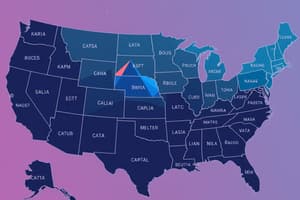Podcast
Questions and Answers
Which of the following best describes a primary challenge to food production in Alaska's tundra?
Which of the following best describes a primary challenge to food production in Alaska's tundra?
- Overabundance of natural predators disrupting livestock farming.
- High levels of precipitation causing frequent flooding of arable land.
- Permafrost thawing impacting land stability and short growing seasons. (correct)
- The presence of dense forests hindering agricultural expansion.
In what way does human activity most significantly threaten the desert ecosystems of the U.S. Southwest?
In what way does human activity most significantly threaten the desert ecosystems of the U.S. Southwest?
- Increased frequency of wildfires due to tourism.
- Introduction of invasive species disrupting the food chain.
- Depletion of water sources through urbanization and irrigation. (correct)
- Overgrazing by livestock leading to desertification.
What is a significant environmental consequence of converting grasslands into farmland in the Great Plains?
What is a significant environmental consequence of converting grasslands into farmland in the Great Plains?
- Decreased water usage as crops are more efficient.
- Habitat loss and increased soil erosion. (correct)
- Increased biodiversity due to crop diversification.
- Stabilization of regional climate patterns.
Which sustainable practice directly addresses water scarcity issues in the U.S. Southwest?
Which sustainable practice directly addresses water scarcity issues in the U.S. Southwest?
How do sustainable indigenous practices contribute to food security in tundra ecosystems?
How do sustainable indigenous practices contribute to food security in tundra ecosystems?
What is the primary threat to the Alaskan tundra ecosystem due to oil drilling?
What is the primary threat to the Alaskan tundra ecosystem due to oil drilling?
Which of these is a key characteristic of the U.S. Great Plains grasslands?
Which of these is a key characteristic of the U.S. Great Plains grasslands?
Why is water scarcity a major challenge for food production in the U.S. Southwest deserts?
Why is water scarcity a major challenge for food production in the U.S. Southwest deserts?
How might climate change exacerbate the challenges faced by food production in the tundra?
How might climate change exacerbate the challenges faced by food production in the tundra?
Which strategy can best help to sustainably manage water resources within grassland regions?
Which strategy can best help to sustainably manage water resources within grassland regions?
Which of the following is a typical characteristic of the tundra biome in the United States?
Which of the following is a typical characteristic of the tundra biome in the United States?
How do altered river flows for irrigation impact desert ecosystems in the U.S. Southwest?
How do altered river flows for irrigation impact desert ecosystems in the U.S. Southwest?
What effect does the conversion of natural habitat to farmland have on native animal populations?
What effect does the conversion of natural habitat to farmland have on native animal populations?
What role do native grasses play in maintaining healthy grassland ecosystems?
What role do native grasses play in maintaining healthy grassland ecosystems?
Why are traditional land management practices effective in dealing with the challenges in the tundra?
Why are traditional land management practices effective in dealing with the challenges in the tundra?
How does the Colorado River Conservation Plan support sustainability in the U.S. Southwest?
How does the Colorado River Conservation Plan support sustainability in the U.S. Southwest?
What is an effect of using drought-resistant crops in areas prone to water scarcity?
What is an effect of using drought-resistant crops in areas prone to water scarcity?
Which explains why rodeo is closely associated with the grassland biome?
Which explains why rodeo is closely associated with the grassland biome?
Which factor primarily dictates the types of plants and animals that inhabit a particular biome?
Which factor primarily dictates the types of plants and animals that inhabit a particular biome?
What is the most likely consequence of continued urbanization in U.S. desert regions?
What is the most likely consequence of continued urbanization in U.S. desert regions?
Flashcards
Alaskan Tundra Climate
Alaskan Tundra Climate
Cold winters (-30°C) and cool summers (3–12°C) with low precipitation (150–250 mm annually). Supports mosses, dwarf shrubs, caribou, and arctic foxes.
Southwest Desert Climate
Southwest Desert Climate
Scorching summers (up to 40°C), cold nights, and minimal rainfall (250 mm annually). Home to cacti, rattlesnakes, and coyotes.
Great Plains Grassland Climate
Great Plains Grassland Climate
Warm summers (30°C), cold winters (-20°C), and moderate rainfall (500–900 mm annually). Features grasses, bison, prairie dogs, and meadowlarks.
Human Impact on Alaskan Tundra
Human Impact on Alaskan Tundra
Signup and view all the flashcards
Human Impact on Great Plains Grasslands
Human Impact on Great Plains Grasslands
Signup and view all the flashcards
Human Impact on Southwest Deserts
Human Impact on Southwest Deserts
Signup and view all the flashcards
Challenges to Food Production: Alaskan Tundra
Challenges to Food Production: Alaskan Tundra
Signup and view all the flashcards
Challenges to Food Production: Southwest Desert
Challenges to Food Production: Southwest Desert
Signup and view all the flashcards
Water Conservation Techniques
Water Conservation Techniques
Signup and view all the flashcards
Sustainable Indigenous Practices
Sustainable Indigenous Practices
Signup and view all the flashcards
Study Notes
- The United States contains tundra, desert, and grassland biomes.
Tundra
- Found in Alaska
- Experiences cold winters reaching -30°C
- Cool summers ranging from 3–12°C
- Receives low precipitation, 150–250 mm annually
- Supports mosses, dwarf shrubs, caribou, and arctic foxes
Desert
- Located in the Southwest (Arizona, New Mexico, California, and Utah)
- Features scorching summers up to 40°C, with cold nights
- Has minimal rainfall, around 250 mm annually
- Hosts cacti, creosote bushes, rattlesnakes, and coyotes
Grassland
- Found in the Great Plains (Kansas, Nebraska, South Dakota, North Dakota, Oklahoma, and Texas)
- Experiences warm summers around 30°C and cold winters dropping to -20°C
- Receives moderate rainfall of 500–900 mm annually
- Contains grass, bison, prairie dogs, and meadowlarks
- Suitable for farming, country, and rodeo activities
Human Alterations
- Humans alter U.S. biomes to meet needs, impacting ecosystems.
- Conversion is driven by need for energy, agriculture, and urbanization, which has significantly altered natural ecosystems.
- In Alaska's tundra, oil drilling and infrastructure disrupt permafrost and wildlife.
- Great Plains grasslands have been converted into farmland for domestic food production, causing habitat loss and soil erosion.
- Southwest deserts face urban expansion and irrigation that deplete water sources like the Colorado River to support that agriculture.
Challenges to Food Production
- Two challenges which the U.S. is struggling to produce food.
- Tundra (Alaska): Permafrost thawing disrupts ecosystems, reduces available land for agriculture, and affects indigenous food sources like hunting and fishing; climate change reduces the amount of hunting and fishing possible. Short growing seasons also limit crop production.
- Desert (Southwest): Water scarcity and extreme heat make irrigation costly and unsustainable, decreasing the crop yield. Droughts and declining groundwater levels reduce crop yields, making farming difficult.
Sustainable Practices
- Two sustainable practices that can be/have been implemented to address the challenges
- Water Conservation Techniques (Desert & Grasslands): Implemented drip irrigation, rainwater harvesting, and drought-resistant crops to reduce water waste in dry regions, these techniques can be implemented throughout the United States, from the desert southwest to the grasslands. Programs like the Colorado River Conservation Plan help manage water use.
- Sustainable Indigenous Practices: Supporting traditional hunting, fishing, and land management ensures food security while protecting ecosystems affected by permafrost thawing.
Studying That Suits You
Use AI to generate personalized quizzes and flashcards to suit your learning preferences.




